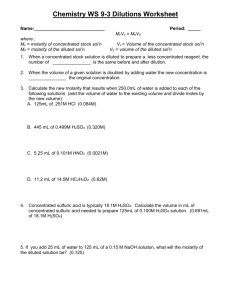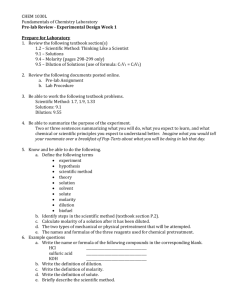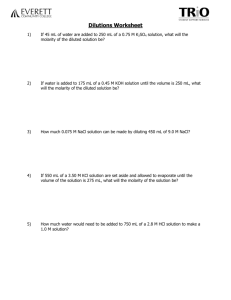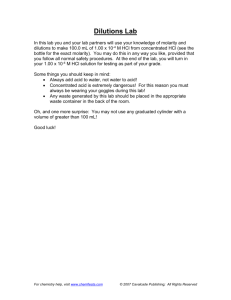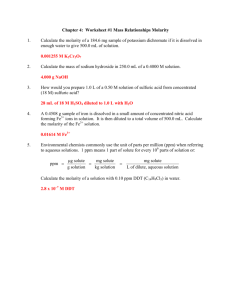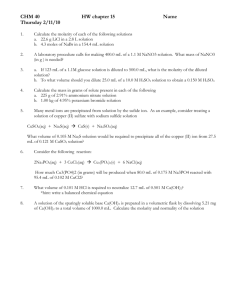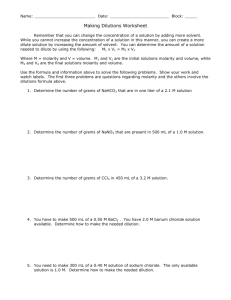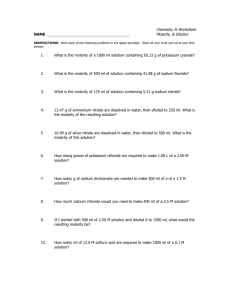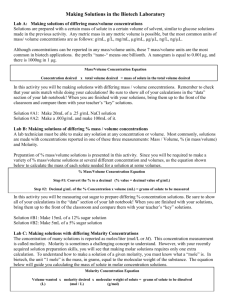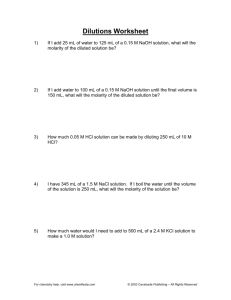prob_solv_wkbk2
advertisement
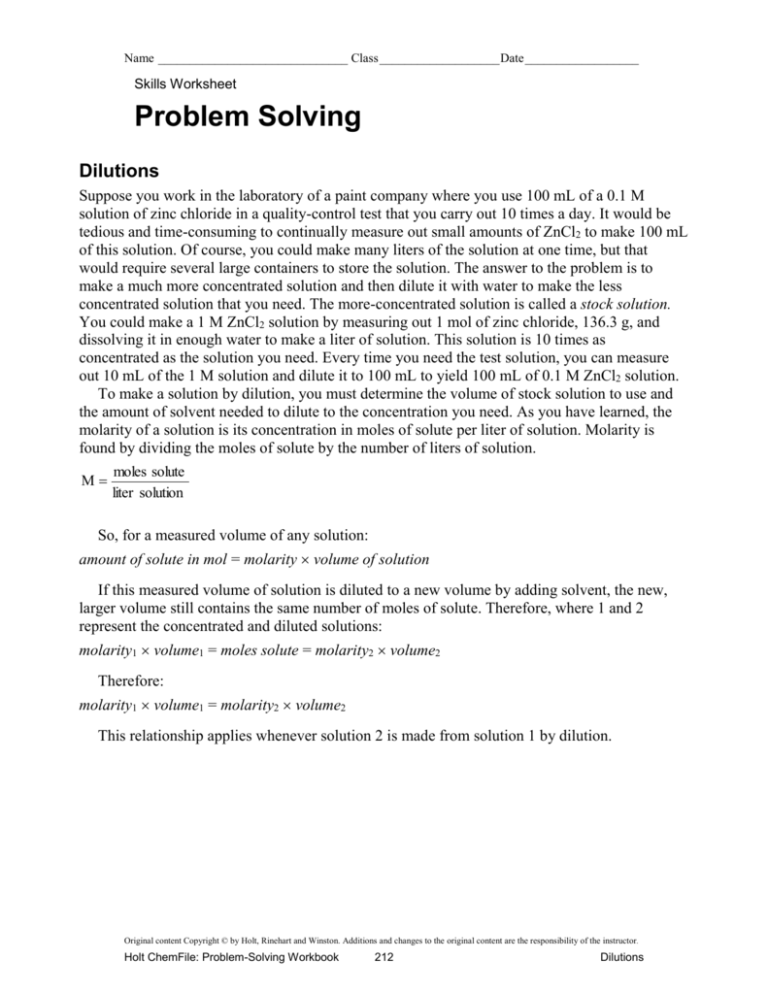
Name ______________________________ Class ___________________ Date __________________ Skills Worksheet Problem Solving Dilutions Suppose you work in the laboratory of a paint company where you use 100 mL of a 0.1 M solution of zinc chloride in a quality-control test that you carry out 10 times a day. It would be tedious and time-consuming to continually measure out small amounts of ZnCl2 to make 100 mL of this solution. Of course, you could make many liters of the solution at one time, but that would require several large containers to store the solution. The answer to the problem is to make a much more concentrated solution and then dilute it with water to make the less concentrated solution that you need. The more-concentrated solution is called a stock solution. You could make a 1 M ZnCl2 solution by measuring out 1 mol of zinc chloride, 136.3 g, and dissolving it in enough water to make a liter of solution. This solution is 10 times as concentrated as the solution you need. Every time you need the test solution, you can measure out 10 mL of the 1 M solution and dilute it to 100 mL to yield 100 mL of 0.1 M ZnCl2 solution. To make a solution by dilution, you must determine the volume of stock solution to use and the amount of solvent needed to dilute to the concentration you need. As you have learned, the molarity of a solution is its concentration in moles of solute per liter of solution. Molarity is found by dividing the moles of solute by the number of liters of solution. moles solute M liter solution So, for a measured volume of any solution: amount of solute in mol = molarity volume of solution If this measured volume of solution is diluted to a new volume by adding solvent, the new, larger volume still contains the same number of moles of solute. Therefore, where 1 and 2 represent the concentrated and diluted solutions: molarity1 volume1 = moles solute = molarity2 volume2 Therefore: molarity1 volume1 = molarity2 volume2 This relationship applies whenever solution 2 is made from solution 1 by dilution. Original content Copyright © by Holt, Rinehart and Winston. Additions and changes to the original content are the responsibility of the instructor. Holt ChemFile: Problem-Solving Workbook 212 Dilutions Name ______________________________ Class ___________________ Date __________________ Problem Solving continued General Plan for Solving Dilution Problems Sample Problem 1 What is the molarity of a solution that is made by diluting 50.00 mL of a 4.74 M solution of HCl to 250.00 mL? Solution ANALYZE What is given in the problem? What are you asked to find? the molarity of the stock solution, the volume used to dilute, and the volume of the diluted solution the molarity of the diluted solution Items Data Concentration of the stock solution (M1) Volume of stock solution used (V1) Volume of diluted solution (V2) Concentration of the diluted solution (M2) 4.74 M HCl 50.00 mL 250.00 mL ?M PLAN What step is needed to calculate the concentration of the diluted solution? Original content Copyright © by Holt, Rinehart and Winston. Additions and changes to the original content are the responsibility of the instructor. Holt ChemFile: Problem-Solving Workbook 213 Dilutions Name ______________________________ Class ___________________ Date __________________ Apply the principle that volume1 molarity1 = volume2 molarity2. 1 rearrange the equation M1V1 M 2V2 algebraically to solve for M 2 2 M 1V1 M 2 V2 M 2 substituteeach of the known quantities for its symbol and calculate M 1 V1 V2 given M2 M1 V1 V2 COMPUTE Note: Even though molarity is moles per liter, you can use volumes in milliliters along with molarity whenever the units cancel. 4.74 M 50.00 mL M2 0.948 M 250.00 mL Sample Problem 2 What volume of water would you add to 15.00 mL of a 6.77 M solution of nitric acid in order to get a 1.50 M solution? Solution ANALYZE What is given in the problem? What are you asked to find? the molarity of the stock solution, the volume of stock solution, and the molarity of the diluted solution the volume of water to add to make the dilute solution Items Data Concentration of the stock solution (M1) Volume of stock solution used (V1) Molarity of the diluted solution (M2) Volume of diluted solution (V2) Volume of water to add 6.77 M HNO3 15.00 mL 1.50 M HNO3 ? mL ? mL PLAN What steps are needed to calculate the amount of water to add to dilute a solution to the given molarity? Apply the principle that volume1 molarity1 = volume2 molarity2. Subtract the stock solution volume from the final volume to determine the amount of water to add. Original content Copyright © by Holt, Rinehart and Winston. Additions and changes to the original content are the responsibility of the instructor. Holt ChemFile: Problem-Solving Workbook 214 Dilutions Name ______________________________ Class ___________________ Date __________________ COMPUTE V2 6.77 M 15.00 mL 67.7 mL 1.50 M 67.7 mL 15.00 mL = 52.7 mL H2O Additional Problems 1. What is the molarity of a solution of ammonium chloride prepared by diluting 50.00 mL of a 3.79 M NH4Cl solution to 2.00 L? 2. A student takes a sample of KOH solution and dilutes it with 100.00 mL of water. The student determines that the diluted solution is 0.046 M KOH, but has forgotten to record the volume of the original sample. The concentration of the original solution is 2.09 M. What was the volume of the original sample? 3. A chemist wants to prepare a stock solution of H2SO4 so that samples of 20.00 mL will produce a solution with a concentration of 0.50 M when added to 100.0 mL of water. a. What should the molarity of the stock solution be? b. If the chemist wants to prepare 5.00 L of the stock solution from concentrated H2SO4, which is 18.0 M, what volume of concentrated acid should be used? c. The density of 18.0 M H2SO4 is 1.84 g/mL. What mass of concentrated H2SO4 should be used to make the stock solution in (b)? 4. To what volume should 1.19 mL of an 8.00 M acetic acid solution be diluted in order to obtain a final solution that is 1.50 M? 5. What volume of a 5.75 M formic acid solution should be used to prepare 2.00 L of a 1.00 M formic acid solution? 6. A 25.00 mL sample of ammonium nitrate solution produces a 0.186 M solution when diluted with 50.00 mL of water. What is the molarity of the stock solution? Original content Copyright © by Holt, Rinehart and Winston. Additions and changes to the original content are the responsibility of the instructor. Holt ChemFile: Problem-Solving Workbook 215 Dilutions Name ______________________________ Class ___________________ Date __________________ 7. Given a solution of known percentage concentration by mass, a laboratory worker can often measure out a calculated mass of the solution in order to obtain a certain mass of solute. Sometimes, though, it is impractical to use the mass of a solution, especially with fuming solutions, such as concentrated HCl and concentrated HNO3. Measuring these solutions by volume is much more practical. In order to determine the volume that should be measured, a worker would need to know the density of the solution. This information usually appears on the label of the solution bottle. a. Concentrated hydrochloric acid is 36% HCl by mass and has a density of 1.18 g/mL. What is the volume of 1.0 kg of this HCl solution? What volume contains 1.0 g of HCl? What volume contains 1.0 mol of HCl? b. The density of concentrated nitric acid is 1.42 g/mL, and its concentration is 71% HNO3 by mass. What volume of concentrated HNO3 would be needed to prepare 10.0 L of a 2.00 M solution of HNO3? c. What volume of concentrated HCl solution would be needed to prepare 4.50 L of 3.0 M HCl? See (a) for data. 8. A 3.8 M solution of FeSO4 solution is diluted to eight times its original volume. What is the molarity of the diluted solution? 9. A chemist prepares 480. mL of a 2.50 M solution of K2Cr2O7 in water. A week later, the chemist wants to use the solution, but the stopper has been left off the flask and 39 mL of water has evaporated. What is the new molarity of the solution? 10. Commercially available concentrated sulfuric acid is 18.0 M H2SO4. What volume of concentrated H2SO4 would you use in order to make 3.00 L of a 4.0 M stock solution? Original content Copyright © by Holt, Rinehart and Winston. Additions and changes to the original content are the responsibility of the instructor. Holt ChemFile: Problem-Solving Workbook 216 Dilutions
